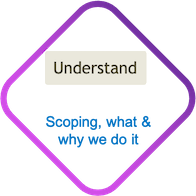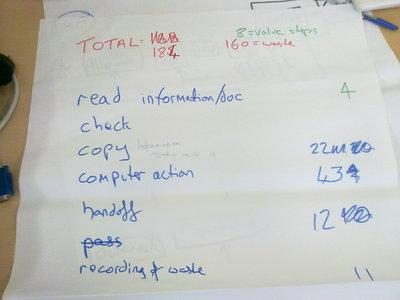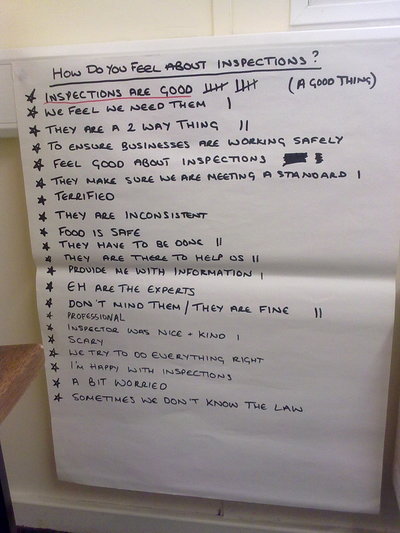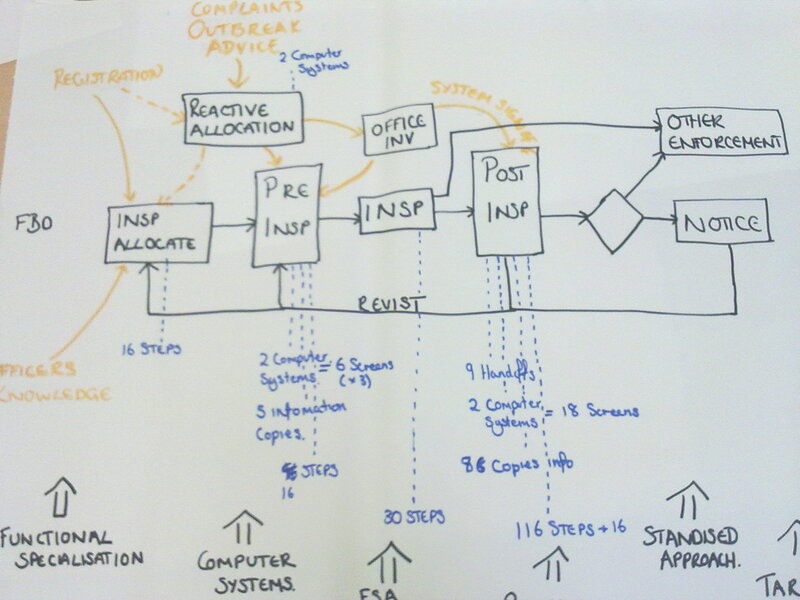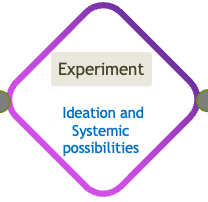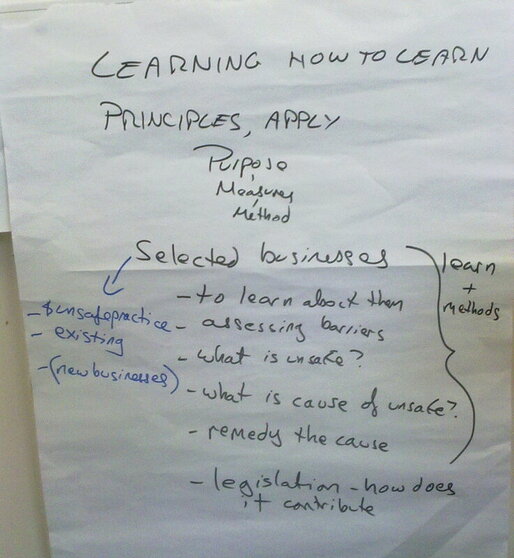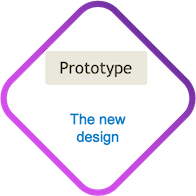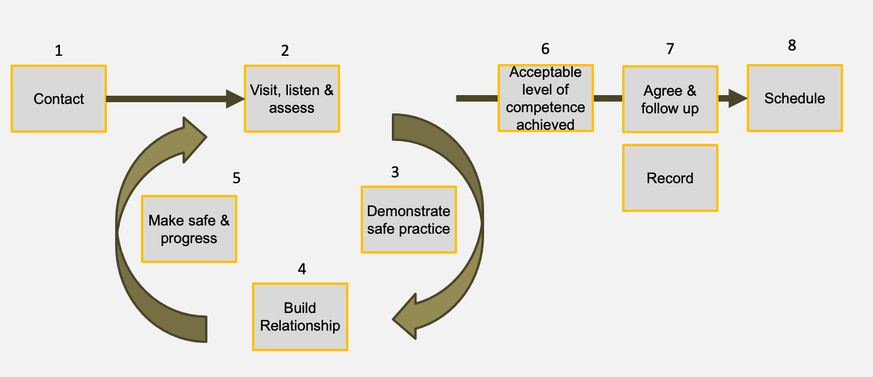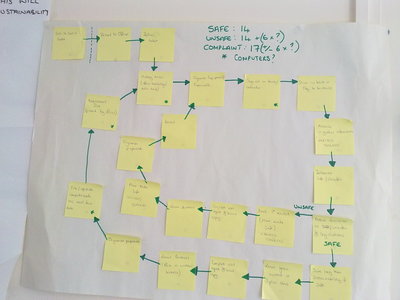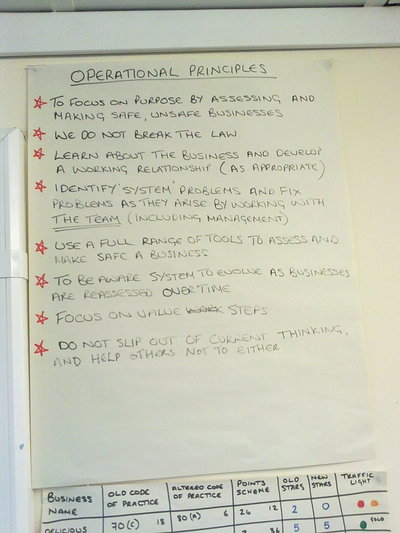Environmental health service design
Moving from enforcing and fear, to understanding and helping
Enforcement services are recognised as those public sector services that are designed around stopping people from doing something; littering, noise, anti social behaviour are good examples.
The services are always backed by legislation that defines the limits of what is acceptable, and those in the service often see themselves as having to ‘police’ or defend something.
Typically, for most services the way they work is that there is a warning, then possibly a fine. Interestingly it is often the case that staff wear uniforms of some type, that adds to their authority.
Below is an example of a Food Safety Team from local government in England, using a service design, Lean and systems thinking approach to challenge and redesign their current way of working.
The team - Transforming thinking is something that happens when people decide to explore and accept other possibilities. So, the team that went through this had to be officers from the organisation, plus the Assistant Director and service manager. They had to undergo the journey, and the only way to do that was for them to actually do it and lead it themselves.
The Plan was agreed with the client - they already had experience of this type of approach with another service design.
The services are always backed by legislation that defines the limits of what is acceptable, and those in the service often see themselves as having to ‘police’ or defend something.
Typically, for most services the way they work is that there is a warning, then possibly a fine. Interestingly it is often the case that staff wear uniforms of some type, that adds to their authority.
Below is an example of a Food Safety Team from local government in England, using a service design, Lean and systems thinking approach to challenge and redesign their current way of working.
The team - Transforming thinking is something that happens when people decide to explore and accept other possibilities. So, the team that went through this had to be officers from the organisation, plus the Assistant Director and service manager. They had to undergo the journey, and the only way to do that was for them to actually do it and lead it themselves.
The Plan was agreed with the client - they already had experience of this type of approach with another service design.
The design for change
We are using these three stage method.
Understand is the analysis of the current system, its performance and the impact on the customer. The customer being the restaurant owner. The approach that was used was to take a team of inspectors and the manager through a series of stages of learning and prototyping - they started by understanding what mattered to the restaurant manager. They also mapped out all the activities that they took to complete a visit.
Systems thinking concept - The start of the process has to be to ask why are we here - our purpose?
Design thinking concept - And then we have to understand HOW we achieve this purpose from an outside in perspective. Then we can truly get the customer experience, fully in our mind.
Systems thinking concept - The start of the process has to be to ask why are we here - our purpose?
Design thinking concept - And then we have to understand HOW we achieve this purpose from an outside in perspective. Then we can truly get the customer experience, fully in our mind.
When looking at food safety if you ask them what their job is, they would say the purpose is to;
enforce food standards on restaurant owners.
They have the ability to fine, or even to take the owner to Court, if they think it is appropriate. For the restaurant owner, the experience is never one that they enjoy - the officer suddenly turns up at my door, telling me that I am here to inspect you.
How we used to work
- A stern officer arrives suddenly in my restaurant.
- “Please give me a place I can change my clothes”
- I wait, and worry about all the things I have not got right in my kitchen.
- The officer comes into my kitchen all dressed in white, with a clip-board. They ignore me, and look into every corner of my kitchen.
- They ask me for my staff training records, and I have two new staff who have not completed the training.
- After 30 minutes, they take me into my office, and they tell me what I am doing wrong.
- The inspector did not see what I was dong right, that I have been very busy this week, and that I am trying my best. I hate them, I try and hide things from them.
The officer usually has a list of items they expect to see; clean surfaces, training records & certificates, proof of inspections, and so on.
At the end of the visit the officer will go back to their office, and type up a reference document that lists all the items that failed the inspection. Each problem will include sections from the legislation, and a warning of when they should be completed. The tone of the letter is very standard and official - and the wording must be written assuming that the letter might be shown in Court.
The workflow
The Systems thinking concept is - we had to ask ourselves how effective the current system was? The answer was, we didn't know. But we do know that owners do not like to see us, and they try and hide bad practice from us. And we know that there are plenty of bad restaurants out there!
The end to end flow of work
The overall flow consists of 184 separate actions, summarised into these main steps;
The overall flow consists of 184 separate actions, summarised into these main steps;
|
Typically, a visit takes:
1 hour to prepare 1 hour to inspect 1 hour to record |
Hardly the indicators of an effective, agile flow!
Characteristics of the Old System
- We enforce.
- We go and inspect when we want to.
- Talking to people is unprofessional.
- We test and tell them what we found.
- We look for compliance; training certificates, records, temperatures.
- We tell them what to do, people are nervous of us.
- We are driven by a schedule, defined by ‘the bible’, code of practice.
- Everything we do is set out in the code of practice.
- We enforce.
- We go and inspect when we want to.
- Talking to people is unprofessional.
- We test and tell them what we found.
- We look for compliance; training certificates, records, temperatures.
- We tell them what to do, people are nervous of us.
- We are driven by a schedule, defined by ‘the bible’, code of practice.
- Everything we do is set out in the code of practice.
At the end of Understand, the Assistant Director and the team were not happy with what they were doing, and they were shocked by the really long flow of work, but they could not see any other way of doing this work.
The task I had was to help them create some new ways of looking at this work!
The task I had was to help them create some new ways of looking at this work!
Experimenting Steps
I had no real idea what the team were meant to come up with, as this was my first time with such a service. On day one, we discussed a new set of principles, and the team went out to learn.
- We are here to learn, and making mistakes is a part of this. We actually have to learn how to learn!
- We understand what matters for each customer, and design around that.
- We make decisions based on data and knowledge, not opinion or standards.
- Deal with the demand entirely and take ownership end to end.
- Work as a team.
Rule 1 - do not break the law.
Rule 2 - do not make their situation worse.
So...
We went to visit restaurants to rediscover what matters to them, and how we can improve food safety from a new perspective. Leaving behind our regulatory and enforcement thinking in the office.
Day 2 was not good, it was confusing for them.
Day 3 was better, one of the pairs had realised that we needed to look at them as people, engage in conversation, and get to know them.
The concept of staff liberating their engrained method was difficult!
We had to learn to;
1. Listen to what they are saying, why they were doing it, and the implications,
2. Learn about their situation, problems, their abilities,
3. As a team, discuss what to do next, focused on purpose and not legislation.
4. Try out what seems to be the best method in the situation to help them to create safe food practice.
I had no real idea what the team were meant to come up with, as this was my first time with such a service. On day one, we discussed a new set of principles, and the team went out to learn.
- We are here to learn, and making mistakes is a part of this. We actually have to learn how to learn!
- We understand what matters for each customer, and design around that.
- We make decisions based on data and knowledge, not opinion or standards.
- Deal with the demand entirely and take ownership end to end.
- Work as a team.
Rule 1 - do not break the law.
Rule 2 - do not make their situation worse.
So...
We went to visit restaurants to rediscover what matters to them, and how we can improve food safety from a new perspective. Leaving behind our regulatory and enforcement thinking in the office.
Day 2 was not good, it was confusing for them.
Day 3 was better, one of the pairs had realised that we needed to look at them as people, engage in conversation, and get to know them.
The concept of staff liberating their engrained method was difficult!
We had to learn to;
1. Listen to what they are saying, why they were doing it, and the implications,
2. Learn about their situation, problems, their abilities,
3. As a team, discuss what to do next, focused on purpose and not legislation.
4. Try out what seems to be the best method in the situation to help them to create safe food practice.
But I gave them a restriction, that we were not to TELL them what to do, but we had to discover other ways for them to UNDERSTAND the causes of the issues.
It took several days, and we had some breakthroughs. One burger van owner, cleaned up their whole van over a weekend, that would have never happened before! We had to learn what happened, and attempt to replicate that concept to others. Finally, we were getting somewhere!
It took several days, and we had some breakthroughs. One burger van owner, cleaned up their whole van over a weekend, that would have never happened before! We had to learn what happened, and attempt to replicate that concept to others. Finally, we were getting somewhere!
We kept going back to ask the question what was our purpose, and how do we measure that. The team developed a new way of seeing what they were doing...
The measure of success is; do we end up with safe food sustainably?
The measure of success is; do we end up with safe food sustainably?
an example of learning in the experiment
With a non-transactional workflow, it is not easy to see a new way forward. So, I had to do some work to get the creative juices flowing. These are officers who have had 'enforcement' drummed into them, for years. So...
Design thinking - On day one, the team had to learn to learn; about chefs, their behaviours, and attitudes. So, they had to go to a restaurant kitchen, stand int he corner, and learn. On their return one group said that it was really interesting... A good start. We worked on that.
The next day they went out to learn some more. They all went to a burger van, and talked to the owner - asking open questions.
Background - This owner had a poor safety record; he had been asked to replace the floor and put in hot water. But had never done this.
Learning - they learned that this man worked 7 days a week, sometimes making no money. Exhausted at the end of the day. He cared that his customers remained safe. The team were a little confused as to why we were spending time doing this..? We asked him if we could come tomorrow?
Learning - we saw that he was using his spatula for both cooked meats and fresh meat. Not good - but we did not say anything to him. - we were only allowed to learn, not do anything.
Design thinking - The teams task was now to learn, but also to experiment with anything that they thought was useful to help create safe food.
What we did - the next day, on the way to see him, we bought a spatula. When we arrived, he said hello, and gave him the spatula. Guess what he did - after a pause his eyes moistened. No-one had ever done anything like that before. Especially not a food safety inspector! He transformed into a welcoming, human being. He chatted, opened up, and was very friendly.
Learning - we have learned the secret that has been eluding us. We have now understood how to engage with people. This was the first breakthrough.
Design thinking - we now wanted to help him understand how poor he was at food preparation. But the team were not allowed to tell him in ther old way, something else had to happen.
What we did - the team designed a graph with all the burger van type business on, and the axis showed each of the businesses from good to poor. We coloured in the poor section in red. We turned up to visit him, was as we approached, he came out, and led us to his van. He offered us all a drink. Over a conversation, we asked him; "how well do you make safe food?" the answer was; oh, I a not great but not as bad as most people."
We then asked him to point to where he thought he was on the graph. Then we showed him where his business really was. And we said nothing. His eyes started to stare again. We continued a conversation and left.
What we did - after a few days, we returned to learn. Again, he came out and led us to his van, he wanted to show us something. He had fitted a new floor, and he had installed hot water!! iThe time, it was the teams turn to have watery eyes. He was so proud! He had done something the inspectors had asked him to do time and time again, over several years.
Learning - the second secret the team learned, was that when you listen, and engage with someone, and treat them ike a human, they respond cooperatively.
Design thinking - On day one, the team had to learn to learn; about chefs, their behaviours, and attitudes. So, they had to go to a restaurant kitchen, stand int he corner, and learn. On their return one group said that it was really interesting... A good start. We worked on that.
The next day they went out to learn some more. They all went to a burger van, and talked to the owner - asking open questions.
Background - This owner had a poor safety record; he had been asked to replace the floor and put in hot water. But had never done this.
Learning - they learned that this man worked 7 days a week, sometimes making no money. Exhausted at the end of the day. He cared that his customers remained safe. The team were a little confused as to why we were spending time doing this..? We asked him if we could come tomorrow?
Learning - we saw that he was using his spatula for both cooked meats and fresh meat. Not good - but we did not say anything to him. - we were only allowed to learn, not do anything.
Design thinking - The teams task was now to learn, but also to experiment with anything that they thought was useful to help create safe food.
What we did - the next day, on the way to see him, we bought a spatula. When we arrived, he said hello, and gave him the spatula. Guess what he did - after a pause his eyes moistened. No-one had ever done anything like that before. Especially not a food safety inspector! He transformed into a welcoming, human being. He chatted, opened up, and was very friendly.
Learning - we have learned the secret that has been eluding us. We have now understood how to engage with people. This was the first breakthrough.
Design thinking - we now wanted to help him understand how poor he was at food preparation. But the team were not allowed to tell him in ther old way, something else had to happen.
What we did - the team designed a graph with all the burger van type business on, and the axis showed each of the businesses from good to poor. We coloured in the poor section in red. We turned up to visit him, was as we approached, he came out, and led us to his van. He offered us all a drink. Over a conversation, we asked him; "how well do you make safe food?" the answer was; oh, I a not great but not as bad as most people."
We then asked him to point to where he thought he was on the graph. Then we showed him where his business really was. And we said nothing. His eyes started to stare again. We continued a conversation and left.
What we did - after a few days, we returned to learn. Again, he came out and led us to his van, he wanted to show us something. He had fitted a new floor, and he had installed hot water!! iThe time, it was the teams turn to have watery eyes. He was so proud! He had done something the inspectors had asked him to do time and time again, over several years.
Learning - the second secret the team learned, was that when you listen, and engage with someone, and treat them ike a human, they respond cooperatively.
Wen the team had got over their 'enforcement' mindset and learned the fundamental principles of a new way of working, they proceeded to develop a new approach using these principles:
- understand the owner as a person and the situation they are in.
- find ways of helping the owner to see things about their food preparation.
- discuss with them ways forward.
- learn and apply, learn and apply, learn and apply...
After a few weeks, they had learned a new approach that was working!
- understand the owner as a person and the situation they are in.
- find ways of helping the owner to see things about their food preparation.
- discuss with them ways forward.
- learn and apply, learn and apply, learn and apply...
After a few weeks, they had learned a new approach that was working!
The same group of officers, after they have transformed their approach, worked very different. Importantly, hey realised that from a systemic perspective, that their purpose should be to:
help restaurants create safe food.
and that this purpose has to drive their redesign, and how they work. It is the primary test of value.
The new workflow - I asked the team to create a new workflow, with only the 8 value steps in - with no waste. And they got quite close to this task. Letters were discarded, no reports were written, and no unnecessary recording was done on IT systems.
And they were determined not to fulfil a pre-determined list of criteria - no tick list!
And they were determined not to fulfil a pre-determined list of criteria - no tick list!
This is the routine developed in the Prototype, from a restaurant owners perspective;
1 They now first phone me, and ask when it would be a good time to visit.
2 They arrive, they get changed, and we have a conversation about what issues I am facing. I tell them about the two new staff, and how busy I have been.
3 They go to the kitchen and simply watch what is going on, and we discuss things.
3 Then, we have a further conversation and they show my staff a few things that they ask about.
4 The inspectors write down a few points that I should take care of, and ask me if I need any help with them.
5 We discuss my issues, and decide when they will return. In the meantime I spend my time improving what we do, and call the officer when I have any questions. I now realise that these issues are important for my customers and myself.
6, 7, 8 When the officer sees that the owner knows how and is able to produce safe practice, they agree the frequency of regular visits. The officer documents these characteristics in the database.
Back in the office, there is the biggest change:
1 They now first phone me, and ask when it would be a good time to visit.
2 They arrive, they get changed, and we have a conversation about what issues I am facing. I tell them about the two new staff, and how busy I have been.
3 They go to the kitchen and simply watch what is going on, and we discuss things.
3 Then, we have a further conversation and they show my staff a few things that they ask about.
4 The inspectors write down a few points that I should take care of, and ask me if I need any help with them.
5 We discuss my issues, and decide when they will return. In the meantime I spend my time improving what we do, and call the officer when I have any questions. I now realise that these issues are important for my customers and myself.
6, 7, 8 When the officer sees that the owner knows how and is able to produce safe practice, they agree the frequency of regular visits. The officer documents these characteristics in the database.
Back in the office, there is the biggest change:
- Paperwork has reduced by 80%. We only record what we need we need to, and we don’t type formal letters to the restaurants.
- We are not interested in the old measures, so we don’t need to record each problem on the measures system.
- The number of activities we used to do in an inspection flow was 134, now it is 11.
- The purpose has changed from checking, to helping people when they need help. Our motivation has gone right up - I enjoy my work.
- If a restaurant manager has a problem, they will now call up the inspector and ask them for advice.
We can now do two visits in one day, not just one.
Systems thinking - the mindset was the key to everything in this work. As they learned, they unlearned the old ways. One of the greatest frameworks that created the old 'enforce' mindset, was the legislation. They would use the wording of the legislation to act as their bedrock, and as the reason to justify their controlling actions and behaviour.
I had to show them, by working with the owners, that the legislation had to be used:
as a guide to safe food preparation, not as a prescriptive set of words.
That was tough to do with this team, but it worked. They finally had the courage to stand on their own two feet as people, who could help people create safe food.
I had to show them, by working with the owners, that the legislation had to be used:
as a guide to safe food preparation, not as a prescriptive set of words.
That was tough to do with this team, but it worked. They finally had the courage to stand on their own two feet as people, who could help people create safe food.
As an enforcement officer, it is now up to me to decide what I do and how I do it, for each situation I find myself in. It is great to be able to put into practice my knowledge, and help people.
In the office we have regular sessions, where we discuss what were doing, and what techniques we have learned. If any of us ever need help, all of us are there at the end of the phone - but the most helpful person is my manager.
Staff comments from the new system;
In the office we have regular sessions, where we discuss what were doing, and what techniques we have learned. If any of us ever need help, all of us are there at the end of the phone - but the most helpful person is my manager.
Staff comments from the new system;
- I did a visit, returned to my desk. Looked around, got up and got back into my car and did another visit.
- I cant do ‘old style’ visits, don’t send me out to do one!
- I want the next new business.
- I had an existing indian restaurant, that was constantly a real problem. Now, it is safe. And I am confident they will stay safe. Owner illiterate, poor english...
Preparation - Everything about what they did before had to be changed. So procedures, IT systems, measures and tools had to be created.
Showing others - The task of teaching others, then began, and the team realised that they could not just tell their fellow inspectiors what they had to do, they had to show them and work with them. It took time, lots of time. But it worked.
Two members of staff did not like the new way of working, so they decided to leave.
Showing others - The task of teaching others, then began, and the team realised that they could not just tell their fellow inspectiors what they had to do, they had to show them and work with them. It took time, lots of time. But it worked.
Two members of staff did not like the new way of working, so they decided to leave.
Have a look at these videos to experience what it is like now
Outcomes
Old 'enforce' principles of working - Command & Control principles |
New 'help me' principles of working - Person centred principles |
We follow instructions. |
We understand the customer, and their problems. |
We ignore the individual issues with the person. |
We adapt and do the right thing for them. |
We follow the letter of the legislation, and use that as an excuse to act forcefully. |
We use the legislation to guide the reality of how it should be implemented. |
This is just a job, owners dont like me. |
I enjoy my job, it helps people, owners like me. |
We design and impose a standard approach to everyone. |
A flexible service designed around the customer. |
We tell people act to do. |
We help people improve their business. |
Control staff through rigid procedures |
Support and develop staff to do the right thing. |
This is the standard 'enforcement' mindset, where we believe that it is our job to make them do the right thing, by imposing our will through our decisions and an atmosphere of fear. |
A very different approach, where the control and decisions remain with the owner. We support them in the circumstances they are in, to the point where they become confident in their own abilities. |
Summary of performance measures
• The Service improved from requiring special measures to excellent.
• Service ethos changed from enforcement and fear, to helping.
• Waste reduced by 75%.
• Cost saving 24% overall.
• Staff reduced by 2.
• Nationally recognised transformation.
• Customer perception changed from suspicion to welcoming.
• The Service improved from requiring special measures to excellent.
• Service ethos changed from enforcement and fear, to helping.
• Waste reduced by 75%.
• Cost saving 24% overall.
• Staff reduced by 2.
• Nationally recognised transformation.
• Customer perception changed from suspicion to welcoming.
The Implications
Think of those public services that are 'enforcement' - that is about issuing penalties, chasing them, force people to do certain things out of fear. Imagine what would be the implications to the community if those services,
instead of
we enforce
became we help??
instead of
we enforce
became we help??
The roles
My role as the consultant was as the provider of expert concept and techniques, a facilitator, and as a guide. I would give them the right direction and tools at the right time, and they would develop the outcomes. So, no nice clean diagrams from me, they were all generated by the team.
The managers - two of the managers were involved for about 1-2 days a week. They had to start by being part of the team, and they had to learn. Slowly over time they started to learn new ways of interacting with the team and allowing officers to come up with the solutions. The manager had to learn how to work with an empowered and self managing team.
Everything was put up on the walls, because it was created by the team, and it had to be visible at all times.
Client manager: Mark Burns, consultant: John Mortimer - Vanguard Consulting
The managers - two of the managers were involved for about 1-2 days a week. They had to start by being part of the team, and they had to learn. Slowly over time they started to learn new ways of interacting with the team and allowing officers to come up with the solutions. The manager had to learn how to work with an empowered and self managing team.
Everything was put up on the walls, because it was created by the team, and it had to be visible at all times.
Client manager: Mark Burns, consultant: John Mortimer - Vanguard Consulting


